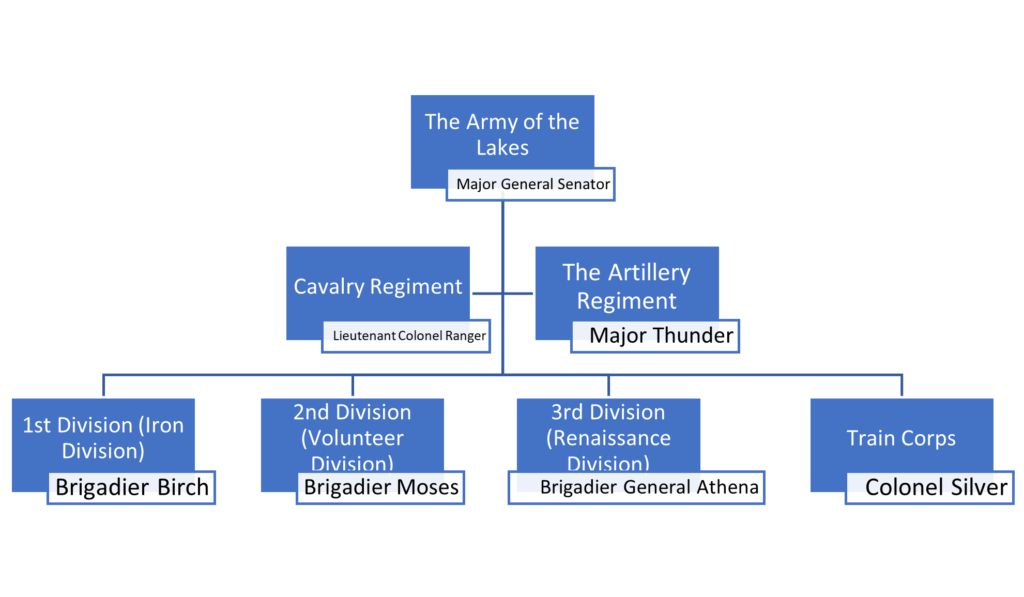The Army of the Lakes is the large formation of troops the RAM trained and prepared over the 2475 – 2476 winter. Its initial Table of Organization puts its total manpower at just over 5,500 personnel, though only about 5,000 were initially raised in time for the 2476 spring offensives, including the Battle of Hunter’s Forest. A second wave of inductees has brought the number closer to 6,000 as of the summer of 2476.

The Headquarters Company
The Headquarters Company of the Army of the Lakes is a small formation of roughly fifty individuals by normal organization. Half of the staff is made up of the officers of the army and their staff. The other half is made up of the headquarters’ security platoon, some of the best trained and equipped troops in the army.
The organization is changed depending on the situation. A signal team is often with the company, while much of the staff might be left behind in combat conditions to keep the headquarters mobile.
| Position | Current officer | |
| Army Commander | Major General Senator | |
| Army Chief of Staff | Colonel Victory | |
| Army Adjutant | Major Thimble | |
| Army Quartermaster | Colonel Auroch | |
| Army Intelligence Officer | Lieutenant Colonel Dusk | |
| Commander Aide-de-Camp | Captain Indigo | |
| Army Senior Non-Com | Sergeant Major David Bell |
The Artillery Regiment
The Artillery Regiment of the Army of the Lakes is responsible for the training and organization of the artillery batteries of the army. The regiment maintains four batteries: one attached to the main army level, consisting of several howitzers captured during the spring battles, and one for each of the three divisions, made up of heavy mortars and several small cannon. Each battery has about eighty individuals, between gun crews, ordnance teams and command staff. The Artillery Regiment is commanded by Major Thunder.
The Cavalry Regiment
The Cavalry Regiment is a force of over three hundred mounted riders, divided into three squadrons of four troops. The regiment’s responsibility is to scout for enemy formations and protect the army from enemy cavalry. While the regiment has some training in raids, so far it has not conducted any. The Cavalry Regiment is commanded by Lieutenant Colonel Ranger.
The Infantry Divisions
The largest components of the Army of the Lakes are the three Divisions. Each division consists of a headquarters platoon, three infantry regiments, and several support components.
The First Division (Brigadier Birch): Called the Iron Division because it includes the concentration of Old Guard volunteers. Consists of the 1st, 4th and 7th Infantry Regiments.
The Second Division (Brigadier Moses): Called the Volunteer Division because it includes the concentrations of defectors and deserters of the Royal Army. Consists of the 3rd, 6th and 9th Infantry Regiments.
The Third Division (Brigadier General Athena): Called the Renaissance Division because it includes the Renaissance Guard, the first raised group of regulars not part of the Old Guard. Consists of the 2nd, 5th and 8th Infantry Regiments.
Division Headquarters
The division headquarters numbers about thirty individuals, half of whom are two squads of rifles for security. Eight to ten staff clerks support the officers of the headquarters. Often the headquarters will be supplemented by a signals team, a medical staff, or other specialist teams.
- Division Commander
- Division Chief-of-Staff
- Division Senior Non-Commissioned Officer
- Division Adjutant (for Administration and Operations)
- Division Intelligence Officer
- Division Quartermaster
- Commander’s Aide-de-Camp
Division Support Components
The Division includes a number of extra units that exist to supplement the divisions’ combat strength or time in camp.
Division Aide Station: Each division has a dedicated aide station of more than a dozen doctors, nurses and medics.
Division Chaplain Team: Each division has a small team of chaplains, usually two officers and several aides, who are responsible for the division’s spiritual wellbeing. In practice, many companies have individuals who had supplemental training and assist in such duties.
Division Artillery Battery: Each division is assigned a battery from the army artillery regiment. The make of each battery can change from each division or even each mission, as weapons and ammunition become available or scarce.
Division Scouts (Chosen Rifles): Each division has a small platoon of ‘Chosen Rifles’, marksmen and scouts. Organizes to scout and harass enemy positions before attacks.
Division Pioneers: Each division has a platoon of combat engineers, trained to assault or demolish enemy fortifications and positions. This platoon is slightly larger than a standard infantry platoon.
The Infantry Regiments
Each division has three infantry regiments, numbered 1 through 9. These regiments make up the bulk of the numbers for each division. When initially raised, each regiment numbered four-hundred and fifty individuals. After the second draft, they’re closer to five-hundred and fifty.
Every regiment has a number, but several also have monikers that are derived from the troops that made up the bulk of their initial cadre, with the Old Guard concentrated in the 1st and 4th regiments (the Iron Guard and Old Line), and the defectors of the Royal Army concentrated in the 3rd and 6th Regiments (the Volunteer Guard and 2nd Volunteers). the 2nd Regiment, composed entirely of new recruits and early volunteers, is called the Renaissance Guard.
Headquarters: The regimental headquarters was initially organized at five officers and a dozen staff. The commanding and executive officers, supported by a regimental adjutant, quartermaster and intelligence officer.
Regimental Aide Station: Each regiment has a dedicated aide station, to care for wounded and send them further up the medical ladder of care. Each aide station has two surgeons, several dedicated nurses and a number of orderlies, for a total of twenty personnel.
Infantry Company: